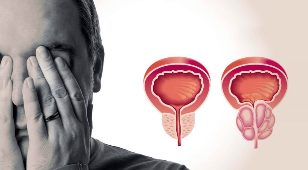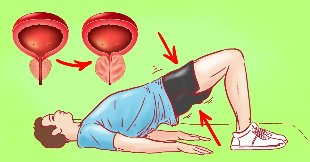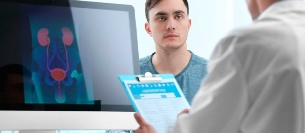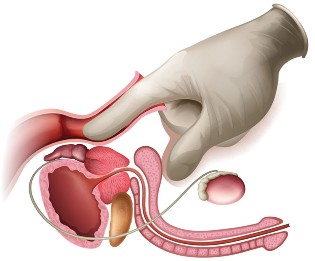The treatment of chronic prostatitis combines medication and physiotherapy. Devices for the treatment and prevention of complications in prostatitis strengthen smooth muscles, normalize the activity of the prostate and increase the speed of tissue regeneration. Not everyone has the opportunity to see a physiotherapist several times a week. There are dozen of homemade prostatitis physical therapy machines available. Look at the devices that have received positive feedback from urologists and see if home appliances can replace physical therapy sessions.

Indications for the use of medical devices
- chronic prostatitis;
- granulomatous prostatitis;
- adhesions, narrowing of the prostate tissue;
- erectile dysfunction;
- urinary tract diseases;
- venous congestion of the small pelvis;
- decreased libido;
- neurogenic disorders.
The acute stage of inflammation is a relative contraindication to the use of equipment to treat prostatitis because of the high risk of complications and the likelihood of the infection spreading to nearby pelvic organs.
Hardware procedures are only displayed in the area of the urogenital diaphragm between the penis and anus.
Contraindications to the use of devices
- severe stage of hemorrhoids;
- anal fissures;
- rectal prolapse;
- megacolon;
- neoplasms (regardless of stage and process location);
- pelvic abscesses;
- thrombus formation;
- acute surgical pathology.
Individual intolerance to invasive methods of device exposure through the rectum leads to the use of external physical devices. The effect of such procedures is significantly less than that of specialized invasive devices for the treatment of prostatitis.

Treatment principles
The hardware technologies include:
- electrical stimulation;
- vibroacoustics (micro-vibration massage);
- laser therapy (soft infrared laser treatment of prostate tissue);
- Magnetotherapy (creation of a magnetic field over the inflammation focus).
Depending on the place of application, all devices for the treatment of diseases of the prostate through the tissue of the perineum can be divided into transrectal and devices with non-invasive action.
Transrectal exposure quickly resolves uncomfortable symptoms as they are exposed directly through the intestinal wall to the posterior surface of the prostate. The use of such devices makes it possible to achieve stable remission without long exacerbations.
Prostate massage is probably the most effective way to do this. Special attachments, included in the set of transrectal devices, allow the prostate to be massaged through the rectum. Such manipulations have a positive effect, as proven by numerous patient reviews, while:
- urination is restored;
- increased blood flow;
- pain decreases;
- The outflow of prostate secretion is stimulated;
- erectile function is improved
Non-invasive treatment through the perineal tissue is less effective but can be used independently at home without the need for special training.
There are different types of devices that affect the affected prostate. You can trade through:
- laser beams of different intensity;
- magnetic field;
- mechanical vibrations;
- electrical impulses through electrodes;
- heat rays;
- ultrasound;
- vacuum;
- complex (combination of acoustic effect and vibration).
The most common devices are based on electrical stimulation. They generate impulses that quickly reach the affected prostate muscles. As a result, the muscles contract, which leads to a positive result in 80% of cases.
Device physiotherapy for prostate diseases is relevant for the intensive treatment of chronic prostatitis or benign hyperplasia.
Active stimulation of blood flow in the prostate parenchyma reduces tissue edema and restores blood flow.
Devices for influencing the prostate have a positive effect on the production of enzymes, specific secretions of the prostate that are necessary for its normal function. The inhibition of the growth of connective tissue against the background of improved blood circulation and intracellular respiration allows the use of these devices not only with prostatitis, but also with prostate adenomas.
Physiotherapy for prostatitis at home
Physiotherapy is a treatment method in which the human body is influenced by various natural factors. These can be electric current, magnetic field, ultrasound and various chemical elements. Physiotherapy is well tolerated by the human body, does not cause any side effects, but at the same time has proven to be effective.
Physiotherapy for prostatitis is carried out during the period of remission of the disease. The acute stage of prostate inflammation, which is accompanied by pain and swelling of the gland, is a contraindication to physical activity. In this case, treatment procedures are not only useless, but can also be harmful and exacerbate the symptoms of the disease.

Physical therapy for chronic prostatitis includes the following methods:
- electric shock;
- magnetotherapy;
- laser therapy;
- ultrasound treatment;
- Mud and mineral water treatment;
- prostate massage.
- Remedial gymnastics.
Let's take a closer look at the individual methods.
During electroplating, the current is direct and continuous. With electrical stimulation, the treatment is carried out with a pulsed current. With darsonvalization, high voltage and low current, pulse and rapid attenuation.
Each method is effective in its own way. Electrophoresis not only helps improve blood circulation in the tissues of the organ, but also helps introduce the drug into the organ. Thanks to the electric current, the drug penetrates the tissues of the prostate better, and recovery is much faster.
Electric shock therapy can be carried out in two ways. It is easiest to place the electrodes in the lower abdomen and in the perineum. However, the method is considered more effective if the electrode is placed in the rectum. This is definitely not very comfortable for the patient, but the treatment has strong anti-inflammatory effects.
Electrophoresis for prostatitis is contraindicated in the following cases:
- For inflammations and injuries of the rectum with the intracavitary technique.
- During an exacerbation of chronic prostatitis.
- In case of intolerance to electric shock.
Electrostimulation treatment is usually performed on an outpatient basis for 10 to 14 days. The duration of the procedure is no more than 15 minutes. Before doing electrophoresis with the medicine, it is advisable to massage the prostate. In this case, the absorption of the drug is better.
Magnetotherapy is a treatment method in which the body is exposed to magnetic fields of different frequencies. A variation of this method is microwave therapy, in which the treatment is carried out with an electromagnetic field.
Magnet is prescribed for acute prostatitis after relief of the main inflammation and for the chronic form of the disease. The method has a pronounced anti-inflammatory effect, promotes the rapid regeneration of prostate tissue and improves organ nutrition.
Magnetotherapy promotes vasodilation, eliminates its spasm and thus restores blood flow to the small pelvis. Thanks to this effect, antibiotics accumulate better in the organ and recovery is noticeably faster.
A contraindication for magnetotherapy is a tumor in the small pelvis, an acute inflammation of the prostate, accompanied by pain and edema, and an intolerance to the magnetic field.
Magnetic physiotherapy can be carried out in different ways:
- The simplest method - electrodes are placed over the projection of the organ and the device is switched on for 15 minutes. The method causes no pain and is easily tolerated by patients.
- In the second method, a catheter is inserted into the urethra or a special electrode is inserted into the rectum. Such treatment is accompanied by unpleasant sensations, but it is more effective, the improvement occurs after the first procedure.
- There is also acupuncture magnetotherapy. In this case, the doctor attaches electrodes to specific biological points. This method is not recognized by official medicine, but many people note its effectiveness.
Separately, such a method of physical therapy as the use of various magnetic jewelry should be mentioned. The effectiveness of this method has not been proven, so you should not replace the procedure prescribed by your doctor with wearing jewelry with magnets.
Laser therapy is a physical therapy method in which a laser beam is applied to the affected organ. The laser beam heats the prostate tissue with the following beneficial effects:
- Stimulates blood circulation and improves metabolism in prostate cells.
- Relieves inflammation and pain.
- Helps to strengthen local immunity, immune cells penetrate the organ more easily and begin to actively suppress pathogenic microorganisms.
- Promotes rapid restoration of the affected area of the prostate.
- It is an excellent way to prevent prostate obstruction and improve the outflow of prostate fluid.
In the case of acute bacterial prostatitis, the presence of neoplasms in the organ and urogenital infections, laser therapy is not carried out.
The laser physiotherapy lasts no longer than 20 minutes. As a rule, up to 14 sessions are prescribed. Treatment is carried out through the tissue of the perineum or through the anus.
During ultrasound treatment, the inflammatory focus is influenced by high-frequency vibrations. A variation of the method is phonophoresis, when the effects of ultrasound and the use of drugs are combined. Ultrasound improves the conductivity of the drug and the effect of the treatment is faster.
For the treatment of prostatitis, the doctor places the top of the device in the pelvic area and on the lower back, usually the minimum dose of ultrasound is used. Only 10-12 procedures are prescribed, the duration of treatment is more than 10 minutes.
Phonophoresis in prostatitis has the following positive effects:
- relieves pain;
- improves microcirculation;
- relieves inflammation;
- improves nerve conduction and potency.
Treatment of mud and mineral water implies the effect of therapeutic mud and mineral water on the inflamed prostate. Treatment is usually carried out in special sanatoriums, where natural conditions make it possible to obtain the material necessary for therapy.
The treatment is carried out in different ways. First, general health baths with therapeutic mud and mineral water are used. Local effects are also shown. Rectal suppositories made from natural ingredients and microclysters are used. Ultraphonophoresis and electrophoresis with mud and salt solutions are also performed.
The positive effects of balneotherapy and mud therapy appear after a few days of active therapy. There is an overall improvement in health, increased efficiency, aching pains go away. Thanks to this method of physiotherapy, nutrition and restoration of the prostate are improved and the risk of chronic prostatitis recurring is reduced.
prostate massage
The doctor usually decides which method of physiotherapy a patient needs. It all depends on the neglect of the disease, the presence of certain symptoms that need to be eliminated. In any case, the hardware treatment of chronic prostatitis is always accompanied by a prostate massage and exercise therapy.
These methods are required and most effective. Physical effects on the prostate itself and the surrounding tissue can improve blood circulation and prevent stagnant processes in the gland.
During prostate massage, an organ is stimulated with a finger through the rectum. The procedure is carried out by proctologists, but if desired, massage can also be done at home. In this case, the patient's partner, relative, or close friend performs the treatment. You shouldn't try to massage the prostate yourself. Such treatment is not effective enough because the patient is unable to relax and fully control his actions.
The process only takes a few minutes and does not cause any major discomfort. The patient lies on their side with their knees on their stomach or stands in a knee-elbow position. It is very important to fully relax and trust the person who will be giving the massage. If the patient is tense, the procedure is painful.
Physical therapy for prostatitis involves daily exercise for the entire body, with an emphasis on the muscles of the pelvis, abdominal muscles, and buttocks. Exercises for the pelvic floor muscles are also very useful and effective. In this type of gymnastics, the man has to strain the muscles of the perineum as if trying to stop urination. You can practice on the toilet and try to stop the flow of urine several times.
Exercise helps make the muscles more elastic and stronger, thereby eliminating urinary incontinence. For correct execution, the pelvic floor muscles are strained and held in this state for 5-10 seconds, preferably as long as possible. Do no more than 10 repetitions. The aim is to increase the duration of the tension to one minute, the number of repetitions does not increase.
Physiotherapy prescribed by a doctor for the treatment of prostatitis is carried out in a polyclinic. The hospital usually has a physiotherapy department or special room with a range of equipment. Usually it is a magnet, a laser, a UHF preparation, etc.
General information
Prostatitis is an uncomfortable, chronic disease. Diseases like to occur regularly and cause pain.
In order to reduce the number of regular hospital visits, various devices have been developed that can be used at home.
Of course, this does not eliminate the need to consult a qualified doctor.

Medical devices for the treatment of prostatitis are a good addition to the main treatment (suppositories and pills), but the expediency of abandoning traditional methods entirely can only be established by a doctor.
These devices are also good for preventative purposes. The disadvantage of this method is its low efficiency in advanced diseases. Severe prostatitis can only be treated with serious clinical equipment.
Medical devices for prostatitis differ in price, physical exposure principles, contraindications and procedures for the procedure.
A device for the treatment of prostatitis at home can have a therapeutic effect with:
- Ultrasound;
- vibrations;
- laser radiation;
- electrical stimulation;
- magnetic field;
- warmth;
- vacuum action.
The most popular are devices for prostatitis based on electric current. In terms of prevalence, they are not inferior to vibration stimulation.
































